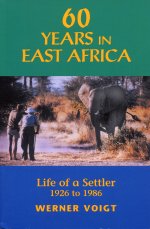60 Years in East Africa: Life of a Settler 1926 to 1986.
This book is the autobiography of Werner Voigt (1905 - 1997). It is written in a flowing conversational style and is an easy read.
Werner writes at the beginning of the book:
This story is written as I remember the different episodes; a bit embroidered, perhaps. I make no claims to the historical accuracy of my account. In many cases, the names have been changed.
As a young boy, Werner Voigt dreamed of reliving the adventures of Robinson Crusoe. In 1926, soon after completing a diploma in "Tropical and Subtropical Agriculture" at the German Colonial College he found himself on his way to Bagamoyo, Tanganyika (now Tanzania) in East Africa on a three year contract with a plantation. That three year contract turned into a sixty year affair with East Africa.
On arriving in Africa, Werner worked as a plantation Manager, running and constructing plantations until the funds dried up during the Great Depression. Fortunately, he had saved sufficient money to purchase land at
Mufindi in the southwestern highlands in the Iringa District. Through his story he shares the hardships, rewards, jubilation and disappointments he and his family experienced: the building of his first house; the arrival from Germany of Helga, his teenage bride-to-be; their 1000 Km honeymoon and gold prospecting trek; the disappointment of the coffee growing failure and the success of their Pyrethrum crop; the eight years of internment in British camps during the Second World War; starting from scratch again as "Tenants at Will" on what had been their own property prior to the War and having to accumulate sufficient funds to repurchase the property; the death of their eldest son, Werner; the success of their tea plantation; and finally, their decision to sell the farm and leave Tanzania in 1986.
Werner's autobiography is filled with many anecdotes containing interesting details about East Africa and the people he knew and loved.
Werner sums up his lifetime in East Africa as follows:
When I arrived in Bagamoyo in 1926, I was called "Bwana mdogo" (little Mister). Later, I was simply, "Bwana". When we got our own plantation, I became "Bwana mkubwa" (big Mister). When Tanzania became independent, we were all just simple "ndugu" (comrades). Later, I became the "Bwana mzee" (old Mister) and in the last years, I was called "Babu" (grandfather). These were the symbols of a lifetime in East Africa.
This book is an interesting read and reveals details of life over the decades in East Africa that you will not encounter in history books.
60 Years in East Africa is available from:
General Store Publishing House
499 O'Brien Rd
Box 415
Renfrew, Ontario K7V 4A6
1-800-465-6072
and can be
ordered online as well.
A worthwhile read. At least that's how I see it from
Between Keyboard and Chair.
Addendum (2008-11-10):
I am not the only one who found this to be a fascinating story. One of the author's daughters forwarded me reviews that appeared after the book was published in the mid 90s.
- Betty Kilgour, Author and Columnist, A number of Betty Kilgour's books have been about her experiences in Africa
"On reading Werner Voigt's magnificent book, 60 Years in East Africa, I was blown away. I found myself embarked on such a magical journey of adventure, joy, sadness and love, I was unable to lay the book down.
Told in a simple, direct, quietly elegant manner, it conveys not only the Voigt's amazing true story of their years in East Africa, but also the love and respect they feel for the African people.
A book as grand as 60 Years in East Africa belongs in the company of such sweeping epics as ... Out of Africa - what a movie this book would make!"
- Dave Brown, Columnist, The Ottawa Citizen. (comments in an Ottawa Citizen column about Werner and Helga Voigt)
"Like most uncommonly competent people, Werner Voigt saw disasters as minor setbacks. The solution to a failed crop was to try another crop. When locusts arrived by the millions, one avoided invitations to barbecues from staff members, who would be offering locusts as a delicacy. They replanted and started again."
- Mora Johnson, Columnist, West End Flyer, Ottawa
"Sixty Years in East Africa is a fascinating autobiography of a person who has chosen an unusual and interesting life. I found the book difficult to put down."
- DRB, Editor of Tanzania Affairs, Issued by the Britain-Tanzania Society, 1997
"This book is a rare gem ... this book is not to be missed ...
It is the adventure-packed, gentle and moving personal story of the 60 years the author spent in Africa ...
Do not start reading it when you are expecting visitors - you might resent the intrusion. Do not start reading it late at night (as I did) - you will miss a night's sleep! And watch out for the film that will surely follow."
